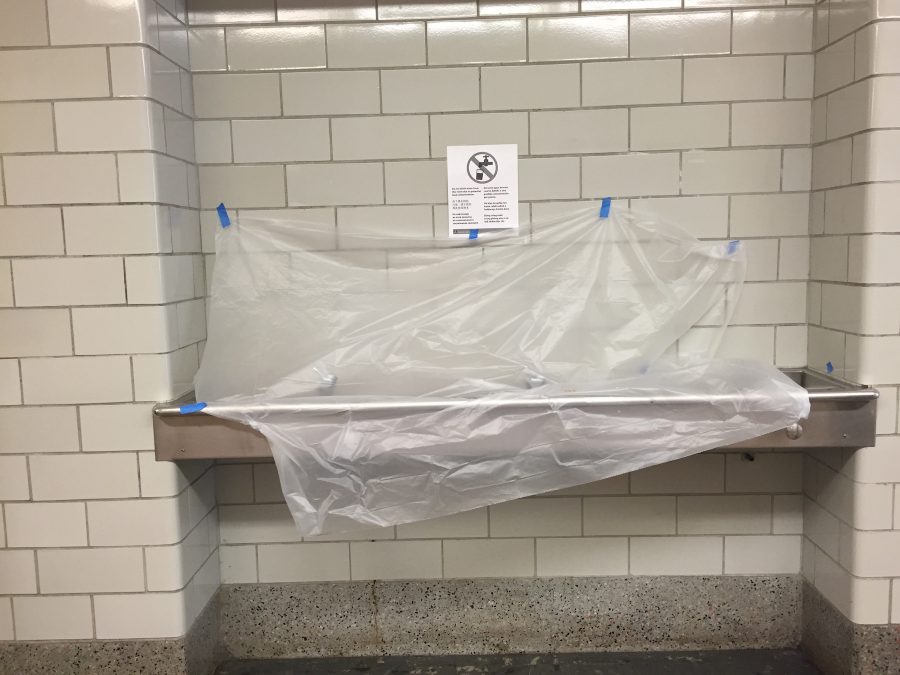Unsafe lead levels at Lincoln mean fountains stay covered
Water fountains remain closed after lead testing found that while none of Lincoln’s fountains contain lead, 80 other fixtures in the school do.
Just eight days before the end of the 2015-2016 school year, Portland Public Schools purchased around $150,000 of plastic water bottles.
It looks like it will have to buy a lot more.
This spending spree was due to a lead issue in the district’s piping that caused many faucets and sinks to contain high amounts of lead. At that time, only a few schools had been tested, but PPS decided that no school’s water supply was safe to drink.
Subsequently, testing over the summer revealed that 3,627 of the district’s water fixtures, or 34 percent, contained lead over the Environmental Protection Agency’s guidance on acceptable lead levels. At Lincoln, over 80 faucets, sinks and spigots tested over the EPA limit.
The discovery of elevated levels of lead in almost every school has troubled the Portland community, mainly because of the health risk lead poses to students.
“In addition to the brain, lead affects lots and lots of other organ systems in the body,” says Tri-County Health Officer, Dr. Paul Lewis, the top health official in Multnomah, Washington and Clackamas counties. Bone marrow, kidneys, and blood pressure can all be damaged, he added.
As well, study after study has proven that lead has long term effects on the development of a young child’s brain.
These health risks mainly stem from drinking lead-contaminated water, not through the skin. While 12 percent of water fountains across the district tested above the limit for lead, screenings conducted by PPS found only 0.7 percent of student and staff tested had elevated levels of lead in their system, and none of these cases have been confirmed as a direct result of PPS, according to a report made to the school board on Aug. 16.
No drinking fountains at Lincoln tested over the EPA limit.
“Lincoln is luckier than most high schools, in that, as far as I can tell none of its drinking fountains had lead, where that wasn’t necessarily true for other high schools,” says Lewis.
Despite many faucets and fountains in Lincoln being safe, students will not be able to drink from any fountains. Instead, the school will most likely provide jugs of water in the hallway that students can use to refill their water bottles, and plastic water bottles for traveling athletes.
Principal Peyton Chapman hopes that students will be allowed to use drinking fountains that are safe, but clearance would have to come from the district.
“No individual school is allowed to create its own policy,” says Chapman. “Ideally we would be able to use the ones [fountains] that are safe.”
“The green clubs and IB Geography students know that plastic water bottles are not the answer.”
In terms of fixing Lincoln’s pipes, both Chapman and Lewis agree that the district should try to find a way to prioritize certain fountains that are essential for drinking and cooking, and work to fix those in the coming year. However, Chapman strongly believes that the only true solution is a full rebuild of Lincoln.
“The longer-term fix is getting these schools rebuilt, and having safe fixtures and pipes and a radon free and asbestos free and lead paint free environment,” says Chapman. “Rebuilding our schools is really a top priority for our city, not just for our school district.”
She added, “We also need to continue to worry about access and school shooters. We should all be worried about earthquakes. We have been trying to get this school rebuilt for 10 years because the minute I walked in this door, I’ve been panicked about the health and safety of our kids. [This summer] defined what the issues were, but we 100 percent need to rebuild our schools.”
“Not only is it about safety, I think the most important piece is about educational adequacy,” Chapman said. She pointed to Lincoln’s robotics classes, which are held in a room adjacent to the kitchen known as the “tomato can room.”
“There’s one electrical outlet, we aren’t even supposed to have kids in there. It’s really hard to offer 21st century STEM initiatives and CTE programs in a completely inadequate facility. The facility starts to impact the instruction. We have fantastic teachers, great kids, families all across our city but schools have become a barrier to teaching and learning.”
The questions of how and when Lincoln will be fixed remain to be answered.

